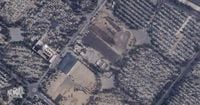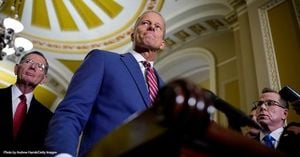In a move that has sparked outrage among human rights activists and the families of victims, Iranian authorities are paving over Plot 41 of Tehran’s Behesht-e Zahra cemetery—an area known as the final resting place of thousands executed in the aftermath of the 1979 Islamic Revolution. Satellite images captured on August 18, 2025, and analyzed by Planet Labs PBC, reveal that roughly half of this sandy, tree-lined patch has already been covered with fresh asphalt, with construction trucks and materials still on site. The project, officially intended to create a parking lot, is proceeding at a rapid pace, likely entombing the remains of those buried beneath.
For decades, Plot 41—sometimes referred to as the “burnt section” or “scorched section”—has been a site of controversy and grief. It holds the graves of an estimated 5,000 to 7,000 individuals whom the Iranian state considered religious outlaws: communists, activists, monarchists, and other opponents of the new theocracy that emerged after the Shah’s fall. Many were executed by firing squad or hanging, their bodies hastily interred without ceremony. The site has long been under surveillance, with security cameras monitoring for any signs of dissent or attempts to honor the dead. Tombstones have been repeatedly damaged or overturned in what critics allege are state-sponsored acts of erasure.
The recent construction has not gone unnoticed. According to Sharq, a reformist Iranian newspaper, both Tehran’s deputy mayor, Davud Gudarzi, and the director of Behesht-e Zahra cemetery, Mohammad Javad Tajik, publicly confirmed the parking lot project in early September 2025. Gudarzi was quoted on state television saying, “The hypocrites from the early days of the Revolution were buried there and it has remained unchanged for years. We proposed that the authorities reorganize the space. Since we needed parking, permission was obtained to prepare the space. The work is being carried out in a precise and smart manner.”
The rationale offered by officials is pragmatic: the new parking lot, Tajik told Sharq, will make it easier for citizens to visit an adjacent plot. This neighboring area is slated to receive the bodies of those killed in the June 2025 war between Israel and Iran—a conflict that saw a major Israeli airstrike campaign resulting in the deaths of prominent Iranian military leaders and, by government estimates, more than 1,060 people. Activist groups claim the death toll may exceed 1,190. The mass burial plans and the need for expanded visitor access have been cited as justification for the cemetery’s redevelopment.
Yet, the move has ignited fierce criticism. Iranian regulations stipulate that cemetery land can only be repurposed after more than 30 years and with the consent of the families of the deceased. It remains unclear whether such consent was sought or granted. Mohsen Borhani, a prominent lawyer in Iran, lambasted the decision in Sharq, calling the paving “neither moral nor legal.” He pointed out that the area was not reserved solely for political prisoners and that ordinary citizens were also buried there. The ambiguity surrounding whether the remains have been exhumed or simply buried under asphalt only deepens the sense of injustice for many families still searching for the graves of their loved ones.
The controversy has also drawn international condemnation. In 2024, a United Nations special rapporteur described the destruction of this section of Behesht-e Zahra as an attempt to “conceal or erase data that could serve as potential evidence of legal accountability.” Shahin Nasiri, a lecturer at the University of Amsterdam who has extensively researched Plot 41, echoed this sentiment. “Most of the graves and tombstones of dissidents have been desecrated, and the trees in that area have been deliberately dried up,” Nasiri stated. “The decision to turn this section into a parking lot fits into a broader pattern and represents the final stage of the destruction process.”
This is not the first time Iranian authorities have faced accusations of erasing the memory of political dissidents. In recent years, other cemeteries holding victims of the 1988 mass executions—a period when thousands of political prisoners were killed—have also been destroyed, often with the remains left at the original execution sites. Cemeteries belonging to the Baha’i religious minority, long persecuted in Iran, and graves of protesters killed in the 2009 Green Movement and the 2022 Mahsa Amini demonstrations, have been similarly targeted for vandalism and demolition.
Hadi Ghaemi, executive director of the New York-based Center for Human Rights in Iran, sees a clear throughline connecting these actions. “Impunity for crimes and crimes against humanity has been growing for decades in the Islamic Republic,” Ghaemi told international press. “There is a direct connection between the massacres of the 1980s, the shooting of protesters in 2009, and the mass killings of protesters in 2019 and 2022.”
Behesht-e Zahra itself is no ordinary cemetery. Opened in 1970 to accommodate the burgeoning population of Tehran during the Shah’s reign, it quickly became a focal point of Iranian history. When Grand Ayatollah Ruhollah Khomeini returned from exile in 1979, he made his first public appearance at the cemetery, where many who died in the uprising against the Shah were buried. After Khomeini’s death in 1989, a grand, gold-domed mausoleum was constructed in his honor, physically linking his legacy to the cemetery and, by extension, to the tumultuous history of modern Iran.
As the city grew, Plot 41 became surrounded by an ever-expanding array of graves. Yet, for many families, the exact location of their relatives’ remains remains a mystery. “Many survivors and family members of the victims continue to search for the graves of their loved ones. They seek justice and strive to hold the perpetrators accountable. The deliberate destruction of these graves represents an additional obstacle to efforts to find the truth and the pursuit of historical justice,” Nasiri emphasized in his research.
The paving over of Plot 41 is, for many, not just a matter of urban development or convenience. It is a potent symbol of the ongoing struggle over memory, justice, and the right to mourn. With fresh asphalt now covering ground where so much blood was spilled, the question remains: can history ever truly be buried?





